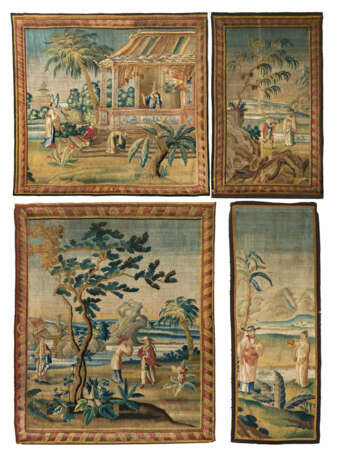ID 953385
Lot 1038 | RARE AND MAGNIFICENT SERIES OF FOUR TAPESTRIES WITH CHINOISERIES
Valeur estimée
€ 20 000 – 30 000
Date: Around 1730.
Maker/Designer: Manufactory Charles Vigne & Jean II Barraban. Berlin - attributed.
Technique: Woven polychrome wool and silk. The edges partially lined with linen fabric.
Description: The series consisting of two larger rectangular and two narrower, vertical rectangular tapestries. Three of the tapestries with narrow frames in red and yellow.
The largest of the four shows an audience scene in a vast landscape with pagoda architecture and palm trees. On the right a large pavilion, its columns and balustrade decorated with porcelain tiles in blue and white. Under the canopy-like roof with billowing curtains stands a Chinese dignitary, wearing fine garments. On and in front of the steps three figures in different postures of obeisance.
The second tapestry depicts another three Chinese figures wearing precious robes. They are placed in exotic vegetation in front of a wide landscape with bizarre rock formations.
One of the narrower tapestries shows a Chinese couple, the other a Chinese man and a boy in jester costumes. Both motifs with exotic tree formations and plants, pagoda architecture and mountain or rock formations.
Measurement: 303x329cm/ 291x245cm/ 322x187cm/ 265x92cm.
Provenance:
From a German aristocratic estate.
Literature:
- Göbel, Heinrich: Wandteppiche. 3. Teil, vol. 2. Die germanischen und slawischen Länder, Leipzig 1934, plate 67a, b & plate 66a, b for very comparable motifs.
- Horbas, Claudia: Tapisserien (1680- 1720), in: Exhibit-cat.: Herrliche Künste und Manufacturen - Fayence, Glas und Tapisserien aus der Frühzeit Brandenburg Preußens 1680 - 1720, p.108 ff.
- Schenk, Peter: Picturae Sinicae Ac Surattenae, Vasis Tabellisque exhibitae, Admiranda; colligente Petro Schenkio cum Privil, Amstelaed, 1702.
- Seidel, Paul: Die Herstellung von Wandteppichen in Berlin, in: Jahrbuch der Königlich Preussischen Kunstsammlungen, 12th vol., 3rd h. (1891), pp. 137-155.
- Standen, Edith A.: The Story of the Emperor of China: A Beauvais Tapestry Series. In: Metropolitan Museum Journal, vol. 11 (1976), pp.103-117.
The series of four tapestries presented here is an impressive example of the great fascination and passion of European courts for East Asian and thus exotic motifs at the beginning of the 18th century. Not only the import of Chinese porcelains or precious silk fabrics had sparked this interest. Also historical events like the visit of the Siamese envoy in 1686 to the court of the Sun King Louis XIV in Versailles, fueled the desire of the ruling classes to have a piece of art in the style of this foreign and therefore fascinating world in their possession. One result of this desire was, for example, the creation of the great tapestry series "L'Histoire du Roi de Chine", which was produced in the Beauvais manufactory from around 1685-90. The commissioner was Louis Auguste I de Bourbon, Duc du Maine, the legitimate son of Louis XIV and Madame de Montespan.
These ten motifs were such a great success that they were reproduced several times over the years for different, illustrious clients. It is therefore not surprising that other manufactories drew inspiration from the series created in Beauvais as well. This is precisely what was done by the Berlin tapestry manufactory of Jean I Barraband (1647 - 1709). He had learned his trade in Aubusson and had come to the Prussian court as a Huguenot. Together with his son Jean II Barraband (1677 - 1725), he laid the foundation for a flourishing manufactory, which initially produced exclusively for the Prussian court. In 1720, Jean II Barraband founded a copany business together with the merchant Charles Vigne, which the latter then continued on his own after Barraband's death. The workshop now also delivered far beyond the borders of Prussia to the courts of Russia, Sweden and Denmark.
The first tapestry series with chinoise scenes by the Barraband manufactory was created in the years around 1714, still quite closely oriented on the designs from Beauvais, which were rich in detail and depicted a lot of figures. The later variants, that were created under the guidance of Charles Vigne, are significantly clearer and more focused in their narrative. They were now based on graphic templates with chinoiseries by the engraver and publisher Peter Schenk the Elder (1660-1711), who was active in Amsterdam. His "Picturae Sinicae" was published in 1702. The Prussian court was very enthusiastic about the exotic and imperial imagery. There is evidence for tapestries of the series that were made for the palaces of Charlottenburg or Schlobitten. Some of them were only documented in the form of photographs that were taken before 1942, but they show clear similarities to the tapestry series presented here. Especially the tapestries from Schlobitten Palace, dated around 1740/50, show extremely comparable wide landscape backdrops with bizarre rock formations and pairs of figures.
Another very apt comparative example can be found with Heinrich Göbel (3.Teil, vol.2, plate 67a). The tapestry listed and illustrated here shows an almost identical, large audience scene with pavilion, differing only in a few minor details. The tapestry, documented in a New York sale, reinforces the attribution of our tapestry sequence to Charles Vigne, created from designs by Barraband. These tapestries from a German aristocratic estate are exceptional in their rarity, demonstrate their involvement in the events at royal courts and are a testimony to the Asiatica enthusiasm of the time.
| Catégorie maison de vente aux enchères: | Tapisseries |
|---|
| Catégorie maison de vente aux enchères: | Tapisseries |
|---|
| Adresse de l'enchère |
VAN HAM Kunstauktionen GmbH Hitzelerstr. 2 50968 Köln Allemagne | ||||||||||||||
|---|---|---|---|---|---|---|---|---|---|---|---|---|---|---|---|
| Aperçu |
| ||||||||||||||
| Téléphone | +49 221 92586215 | ||||||||||||||
| Fax | +49 221 92 58 62 4 | ||||||||||||||
| Commission | 32% | ||||||||||||||
| Conditions d'utilisation | Conditions d'utilisation | ||||||||||||||
| Heures d'ouverture | Heures d'ouverture
|








